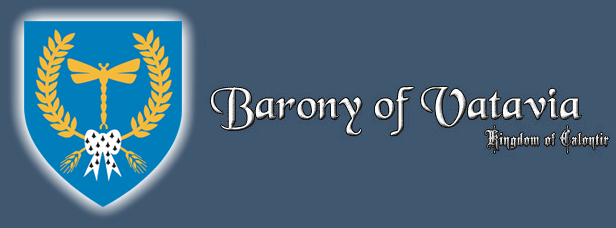
May Day Festivities
by Friar Thomas Bacon (David Moreno)
Orignally published in the April 1983, A.S. XVII issue of the Dragonflyre, a publication of the Barony of Vatavia.
The Society began life as a May Day celebration, and begins it’s year on May Day. The latter is appropriate, for May Day is a celebration of the coming of spring, and of new beginnings. It is akin to Easter, both in its basic roots, and some of its symbolism.
May Day is one of the few festivals which during the Middles Ages, retains its pagan nature. Its origins date to Druidical times, to which the Romans added their festival of Floralia, goddess of flowers and blossoming plants.
The original Celtic holiday is Beltane, and was observed by lighting fire on hilltops to stimulate the sun. On the night before, Walpurgis Night, branches of rowan o buckthorn were fastened to houses to keep away witches. In some parts, mock battles were held between winter and summer, with winter losing.
The Romans expanded the variety and uses of plants in the decoration of homes using branches laden with fruit or flowers. In some places, early riser would go around placing branches on people’s doors. A branch of Hawthorn was a sign of goodwill, while a bunch of nettles or a spray of elder, was an unlucky omen. Robert Herrick describes this scene in a poem:
Come, my Corinna, come; and comming make
How each field turns a street; each street a Parke
Made green, and trimm’d with tress: see how
Devotion gives each Hause a Bough,
O Brand: Each Porch, each doore, ere this,
An Arke a Tabernacle is
Made up of white-thorn neatly enterwove;
As if here were those coole shades of love;There’s not a budding Boy, or Girls, this day,
But is got up, and gone to bring in May,
A deale of Youth, ere this, is come
Back and with White-thorn laden home.
Some have dispatcht their Cakes and Creame,
Before that we have left to dreame:
And some have wept, and woo’d, and plighted Troth,
And chose their Priest, ere we can cast off sloth;
Many a green-grown has been givin;
Many a kisse, both odde and even;
Many a glance too has been sent
From out the eye, Loves firmament;
Many a jest told of the Keyes betraying
This night, and Locks pickt, yet w’are not a Maying.1
Songs would often be sung as they made their rounds. One such song is:
Remember us poor Mayers all,
And thus we do begin
To lead our lives in righteousness,
Or else we die in sin.We have been rambling all this night,
And almost all this day,
And now, returned back again,
We have brought you a branch of May.A branch of May we have brought you,
And at your door it stands,
“This but a sprout, but it’s well budded out
By the work of our Lord’s hands.The hedges and trees, they are so green,
As green as nay look,
Our heavenly Father, he watered them,
With His heavenly dew so sweet.The heavenly gates are opened wide,
Our paths are beaten plain,
And iff a man be not too far gone,
He may return again.The life of man is but a span,
It flourishes like a flower,
We are here today, and gone tomarrow,
And are dead in an hour.The moon shines bright, and the stars give a light,
A little before it is day,
Sod God bless you all, both great and small,
And send you a joyful May.2
Another innovation the Romans introduced is the Maypole. The Maypole is a phallic symbol whose exact meaning and derivation, including maypole dancing, remains unclear from my researches. The maypole also had the secondary purpose of substituting for whole uprooted trees, which on occasion would turn up in front of the home of a zealous lover’s love. As a pagan institution, the maypole came under the attack by the defenders of the church. In 772 Charlemagne ordered one maypole destroyed in Northern Germany. These poles often reached 70 feet in height, and some were reported to be over 100 feet. The name of one church, St. Andrew Undershaft, recalls a maypole which towered over the church steeple.
The maypole dancing would be presided over by the Queen of May, and in the later part of the period, in England, would be joined by Robin Hood and Maid Marian. The queen symbolized the fertility goddess, responsible for the flowering of the fields.
An interesting superstition was that washing in May Day dew was good for the complexion. As one rhyme puts it:
The maiden who,
On the first of May,
Goes to the Fields
at the break of day,
And washes in dew
from the hawthorn tree
Shall ever afterwards
Beautiful be.3
Above all else, May Day is a joyous expression of the release from winter, and all the restriction and tension thereof. Only the coming of the Industrial Revolution, and the estrangement of man from nature, did this oldest of man’s holidays falter. Yet today it enjoys a rebirth of popularity, continuing its long history.
Footnotes
1. Robert Herrick, “Cornna’s going a Maying”, (Patrick 98-100). ^
Bibliography
Chandler, Christine. A Year Book of Customs. London: A.R. Mowbray & Co., 1957. pp. 78-85
Christian, Roy. Old English Customs. New York: Drake Publishers Inc., 1973. pp. 34-39
Hazlitt, William C. Faith and Folklore of the British Isles. New York: Benjamin Blom, 1965. pp. 397-406.
Jones, E.O. Seasonal Feast and Festivities. New York: Barnes & Nobles Books, 1961. pp. 309-314
Patrick, J. Max, ed. The Complete Poetry of Robert Herrick. New York: New York University Press, 1963.
Copyright © 1997 - present His Lordship Friar Thomas Bacon (David Moreno). All rights reserved.